

 Trolley Scan(Pty) Ltd
Trolley Scan(Pty) Ltd
Trolleyponder(TM)
By Mike Marsh,Trolley Scan(Pty) Ltd
Without a doubt the answer is Yes!!!
The question is although it is technical viable, what are the issues governing the commercial viability of such a system??
Radio Frequency Identification transponders (RFID) can be attached to individual items to be identified, and the identities of those transponders can be read by a reader which passes the information onto a computer, so giving the computer "vision" within the volume scanned by the reader. As the system uses radio communication for passing data, it is not necessary for the transponders to be in direct line of sight of the reader such as with barcoding, but just to be in radio communication with the reader.
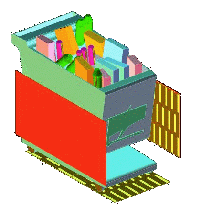 As the reading volume increases, the number of tags to be read at a time
increases and conventional RFID systems start to overload as their protocol
cannot handle the number of signals being emitted from the transponders
at the same time.
As the reading volume increases, the number of tags to be read at a time
increases and conventional RFID systems start to overload as their protocol
cannot handle the number of signals being emitted from the transponders
at the same time.
In some cases the reading volume might contain 400 or more transponders,
and whereas a computer system with networked devices could easily handle
so many devices, radio frequency transponders (tagging) has particular
problems that make this situation complex.
In the computer networked situation, all devices monitor the communications
channel (network cable) and can determine if another device is communicating
or if the communications channel is free. This knowledge about the state
of the communications path, allows the devices to order their communications
so that no two devices interfere, and the maximum throughput of data from
the devices can be obtained through the communications channel.
The signals radiated from individual RFID transponders are very weak, often
in the microwatt power levels. In addition there is often a strong energising
field that is powering up the transponders, generally at a frequency that
is close to that used by the transponders for their transponder to reader
communications. Should a transponder wish to monitor communications from
other transponders, it would need to include a very sensitive receiver
that had sufficient tuned circuitry to reject the swamping by the energising
frequency and yet detect the transmissions from other transponders so that
it could monitor the activity of the transponder to reader communications
channel to create order and not interupt other transmissions. Such a system
of onboard receivers would make the transponders expensive, especially
if they had to stay in tune over a range of temperatures, and would further
require that for world trade, the same frequency would need to be assigned
in all countries. These requirements rule out the viability of monitoring
the communications path by the transponders for communications from other
transponders.
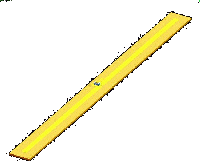 Another possible method of bringing order to the transponder to reader
communications, is to use the reader to control the communications by passing
messages from the reader to the specific transponder, each of which requires
an onboard receiver to decode the incoming message, and a unique address
or identity to monitor the incoming messages and determine when it is being
addressed. In this situation, the transponders still need tuned circuitry
in their receivers to monitor the read to transponder communications, but
the signals are much stronger than those of the transponder to tranponder
communications mentioned above requiring simpler circuitry. Typically in
this mode, the reader polls the transponder, by calling its number and
seeing if it answers, or by letting the transponders broadcast randomly,
and once an identity is detected to broadcast that identity and either
transfer information to the transponder or pass instructions to it to cease
communications to free the communication channel for other devices.
Another possible method of bringing order to the transponder to reader
communications, is to use the reader to control the communications by passing
messages from the reader to the specific transponder, each of which requires
an onboard receiver to decode the incoming message, and a unique address
or identity to monitor the incoming messages and determine when it is being
addressed. In this situation, the transponders still need tuned circuitry
in their receivers to monitor the read to transponder communications, but
the signals are much stronger than those of the transponder to tranponder
communications mentioned above requiring simpler circuitry. Typically in
this mode, the reader polls the transponder, by calling its number and
seeing if it answers, or by letting the transponders broadcast randomly,
and once an identity is detected to broadcast that identity and either
transfer information to the transponder or pass instructions to it to cease
communications to free the communication channel for other devices.
This type of transponder is also relatively expensive due to the onboard
receiver which also has temperature stability problems and requires preplanned
communication frequencies for international trade.
In order to design a system that could be suitable for barcode replacement, it is necessary to develop a protocol that can allow for ordered communication without having onboard receivers on the transponders.
In 1991, the author, while working for a research laboratory of the
South African Government, invented just such a protocol which was patented
and made available for licensing by world companies.
The protocol does not have need for any onboard receivers on the transponders,
but rather uses the changing properties of the energising field as received
by the individual transponders to communicate with all transponders at
the same time, and where the timing of the communication has significance
to the transponders depending on their immediate past transmission status.
In this protocol the transponders randomly transmit their identity data
in a fixed format. The data has certain properties, such as length, header,
parity etc, by which the reader can receive the information and can verify
that the transmission is not corrupted. Immediately after each transmission,
the transponder that has just communicated monitors the "reader to
transponder" channel, which might be as simple as the energising field,
and checks for an acknowledgement. If an acknowledgement is received at
the correct time, despite all transponders receiving the same acknowledgement,
only the transponder that has just communicated responds and all other
transponders ignore the message, the principle being that the acknowledge
message only can happen if a valid uncorrupted message is received and
since the transponder that has just transmitted receives an acknowledge,
its message must have been received. After receiving an acknowledge the
transponder stops communicating, freeing the communication channel for
other transponders until eventually all transponders are shut down.
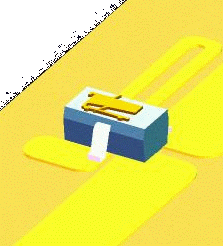 In 1994 the author left government service and started his own small consulting
company with a partner. In 1998 they took the protocol issue closer to
the ultra low cost transponder system by inventing a patenting a more simple
protocol called Trolleyponder. This has been offered to companies around
the world who wish to become involved in very low cost transponder systems
to replace barcoding.
In 1994 the author left government service and started his own small consulting
company with a partner. In 1998 they took the protocol issue closer to
the ultra low cost transponder system by inventing a patenting a more simple
protocol called Trolleyponder. This has been offered to companies around
the world who wish to become involved in very low cost transponder systems
to replace barcoding.
For both the above systems, by using a system called backscatter
modulation, patented in the US in 1969, whereby the transponders reflect
varying amounts of the energising field by modifying their antenna matching
impedances, it is possible to make a transponder that is independant of
frequency, in that the same active components can operate from 100 MHz
to 2.5GHz, just dependent on the antenna resonance and matching. In addition
very wide manufacturing tolerances can be allowed, further increasing yields
for manufacturers and therefore lowering the costs. In the protocols invented
by the author, the actual identity of the tag does not play a part in the
recognition of a tag, and it is possible to have many tags with the same
identity such as might occur at a retailer with all items of the same description
carrying the same product code.
As the transponders already have electronic circuitry onboard, at virtually
no extra cost sophisticated controllable Electronic Article Surveillance
can be added to the transponders, making them suitable as replacements
for barcoding with inbuilt anti-shoplifting features.
In order to have a transponder system that is going to cost a few cents to manufacture, the transponder has to extract its power from an energising field as a battery system would be too expensive. This implies that the transponder needs to be powered up from the energising field throughout the reading session, so that it can remember its status on whether or not it was heard.
Unfortunately it is very difficult to generate a uniform radio frequency energising field in a real situation. The interation between direct and reflected rays from the same source interact, causing RF energy fluctuations throughout the reading volume. In the original development work, the author invented a system of providing the energising field at a number of different frequencies, from different antennas often with different polarizartions, so that no matter what orientation or location the transponder was in the reading volume, it would be in communication with the reader on at least one frequency. Such a system would typically operate on three frequencies, that needed to be sufficiently seperated so that filters could remove the energising frequency of one set from swamping the communications on another set.
In 1998, the author and his partner filed a provisional patent application providing multi axis energising and scanning, while only using a single frequency. This now means that for trolley scannning, only a single frequency will be needed despite the complex RF situation.
The technology is now available to solve this application, the tags are produceable at reasonable costs, but still the scanning trolley has not made an appearance, why?
Production units
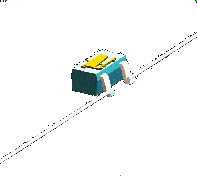 It would appear that the magic number for production quantities of transponders
per licensee when starting up is 100 million transponders per annum. This
is a planning number and would represent the target capacity of a production
unit. Once that unit is fully commisioned further similar units could be
built to be run in parallel.
It would appear that the magic number for production quantities of transponders
per licensee when starting up is 100 million transponders per annum. This
is a planning number and would represent the target capacity of a production
unit. Once that unit is fully commisioned further similar units could be
built to be run in parallel.
The reason 100 million is an important planning number, is:
Although 100 million transponders might appear a large number, it is in fact trivial in an industry where just one of the smaller mail courier's use more than 60 million tags per annum, where 6 000 million EAS tags are sold in Europe alone, and where the grocery industry world wide is estimated to use 10 million million (1013) per annum. (The turnover of such a company would most probably be between US$20 million to US$100 million per annum depending on market sector - definitely not a trivial operation.)
Cost price versus selling price
Trolleyponder is a product that has application in a diverse range
of industries, where the same circuit and the same readers, but maybe a
slightly different form of antenna and packaging, mean that identification
systems can be implimented in products from capital goods and asset management;
to tree logging; to self service clothes and shoes; and even grocery retailing.
It is an intention of the Trolleyponder design to reduce the manufacturing cost price of the transponders as much as possible. This is achieved by investigating design changes to keep the solution simple, and to design around snags that limit the simple production of the circuit and its assembly. However once the cost price is below the selling price, the licensees and investors are relieved and have a sound business. The selling price however is controlled by market factors and Trolley Scan have had to impliment different strategies to bring down the selling price in order to achieve the goal of scanning supermarket trolleys.
If for example the cost price of the tag (transponder) was only US$0-10, but the market price for selling was $1-00, the market price will not be effected even if the cost price of the tag were further reduced to US$0-08. The reason the market price is held so high, is that the supply of the transponders is insufficient to meet the market needs as well as the price sensitivity for transponders being so wide across so many varied applications, where the same technology can be used to label a $1-00 can of beans or a $5000 computer system.
The only way to bring down the selling price is to increase the competition and supply, especially as this one technology has application in many different industries in almost all countries in the world.
Towards the grocery retail market
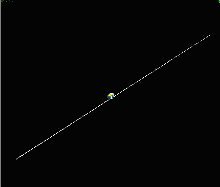 Although it is still some time before there will be sufficient transponders
to enable trolley scanning at supermarkets, in most other industries the
technology and solution is influenced by far fewer parties and the system
can be adopted on a one by one basis almost as soon as transponders become
available. In retailing this would apply to clothing, shoes, books, audio
and video media, and even expensive consumer items.
Although it is still some time before there will be sufficient transponders
to enable trolley scanning at supermarkets, in most other industries the
technology and solution is influenced by far fewer parties and the system
can be adopted on a one by one basis almost as soon as transponders become
available. In retailing this would apply to clothing, shoes, books, audio
and video media, and even expensive consumer items.
For retailing, it is likely that this technology would first appear
on caselots, being used throughout the entire manufacturing, warehousing
and logistics chain to track the progress of the cases, including the benefits
of the inbuilt Electronic Article Surveillance features to stop pilferage.
Its benefit to the retail store owner would be at the back door, where
they receive the caselots for breaking down and stocking their shelves.
This process would allow the more technically advanced grocery manufacturers
to convert to RFID at their own pace, and to optimise the benefits for
their own logistics requirements up to the back door of the retailer.
The retailer would only be able to switch to this technology once all his suppliers have switched and supplies have increased to allow for sufficient transponders for marking at unit level.
What is Trolley Scan trying to do to make this happen
Trolley Scan believe the technology is now available to meet this application
headon.
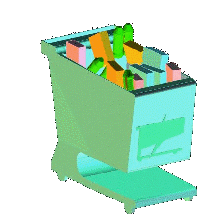 The bottlenecks are the lack of suppliers of transponders and companies
becoming involved in delivering and customising the technology to the end
users needs. To facilitate the growth of this technology, Trolley Scan
are
The bottlenecks are the lack of suppliers of transponders and companies
becoming involved in delivering and customising the technology to the end
users needs. To facilitate the growth of this technology, Trolley Scan
are
Besides the issue of encouraging companies and investors to become involved as licensees and value added resellers, the next hurdle will be to encourage the semiconductor foundries, who seldom have a single product that requires such volumes, to increase capacity to supply sufficient transponders.
"One day the world will have scanning trolleys, it is just a matter of time"